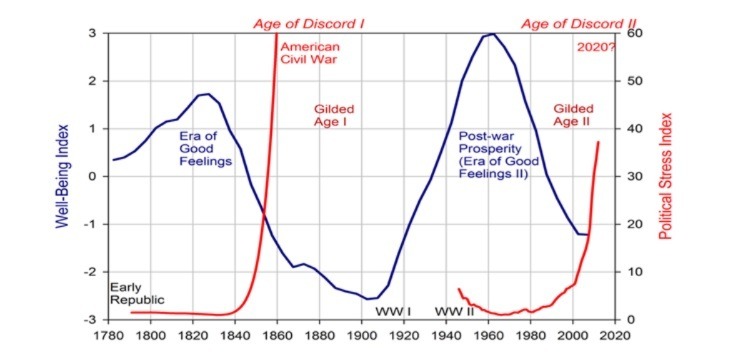Are we to see a future period of growing instability in the United States and Western Europe which would undermine a progressivist vision, and is made calculable in the Turchin and Goldstone’s political stress thesis (explained in the endnote below)?
The predictions here are probably ‘on the money’, that is, the probability of events working out for ‘civil war’ happens to be high. However, the historical methodology in the thinking is confused, and there are no certain predications based on history.
The reason is that history looks backwards and produces approximate calculation on the past events as described; in many cases, an accurate approximation in the description, or even modelled explanation, is arguably produced. This is where the mathematical model goes wrong, even if future events turn out as predicated.
The mathematical model is using future approximation on an existing past approximation, doubling the approximation. In the Well-Being and Political Stress Indexes what we have are the retrospective judgements of historians (or social scientists acting as historians in the data), and thus, reading reports of persons at the time marked, and making secondary judgements at a later time.
There are few and significant factors which are incalculable and they are the surprise events in the unfolding history of the present. They are the accidents of history which come together from the chaos.
There is margin room for hope. And the professional historians know better than to gamble good money, even if the odds are much better than fair.
END NOTES
Acknowledgment: Thanks to literary friend, Robert Gollagher, for bringing the topic to my attention and raising astute questions.

Graphic: The Political Stress Index combines three crisis indicators: declining living standards, increasing intra-elite competition/conflict, and the weakening of the state. Growing PSI indicates likelihood of political violence. The Well-being Index indicates greater equality, greater elite consensus, and a stronger, more legitimate state. Supplied: Jack Goldstone and Peter Turchin in the James Purill article.
REFERENCES
James Purtill. This model forecast the US’s current unrest a decade ago. It now says ‘civil war’, Triple j Hack (website link).
Peter Turchin (2010). Political instability may be a contributor in the coming decade, Nature volume 463 (website link)
Neville Buch
Latest posts by Neville Buch (see all)
- J. D. Vance’s Insult to America is to Propagandize American Modernism - July 26, 2024
- Why both the two majority Australian political parties get it wrong, and why Australia is following the United States into ‘Higher Education’ idiocy - July 23, 2024
- Populist Nationalism Will Not Deliver; We have been Here Before, many times… - July 20, 2024
